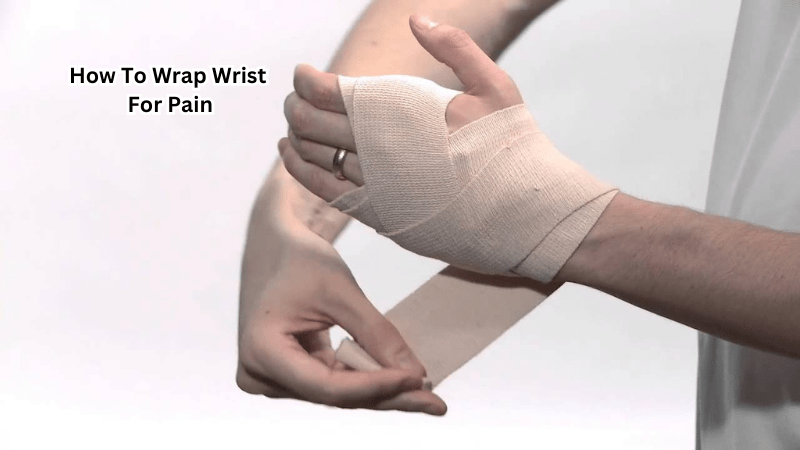Wrapping the wrist for pain relief is a common practice among athletes, individuals with repetitive use injuries, and those recovering from wrist injuries. It involves using an elastic bandage or tape to provide support and compression to the wrist joint, promoting healing and reducing discomfort.
While there are various reasons for wrist pain, such as carpal tunnel syndrome, tendinitis, or sprains/strains, wrapping can help alleviate symptoms in most cases. However, proper technique and understanding of when to wrap are crucial for effective results.
In this guide, we will discuss step-by-step instructions on how to wrap the wrist for pain relief and cover important information about when it is appropriate to do so. Additionally, we will talk about the benefits and potential risks of wrist wrapping, as well as alternative methods for managing wrist pain. Let's get started!
Why Wrap the Wrist?
As mentioned, there are several reasons why individuals may choose to wrap their wrists for pain. The most common reason is to provide additional support and stability to the wrist joint, which can help reduce discomfort and prevent further injury.
Another benefit of wrapping the wrist is compression. The pressure from the bandage or tape helps reduce swelling and inflammation in the area, promoting blood flow and oxygenation to aid in healing.
Wrist wrapping can also improve proprioception, which refers to our ability to sense the position and movement of our body parts. Providing a slight restriction of movement can increase awareness of proper alignment and prevent movements that may aggravate pain.
Additionally, for athletes or individuals who engage in repetitive wrist movements, wrapping can help prevent overuse injuries and provide support during physical activity. It is also commonly used as a part of the rehabilitation process for those recovering from wrist injuries.
When To Wrap Your Wrist?
While wrapping the wrist can be beneficial, it is essential to know when it is appropriate to do so. In general, you should only wrap your wrist if you are experiencing pain or discomfort in the area.
You may also consider wrapping your wrist before engaging in activities that involve repetitive movements or put stress on the joint, such as weightlifting or playing sports. This can help prevent potential injury and improve performance.
However, it is crucial to consult with a healthcare professional if you are experiencing persistent or severe wrist pain. Wrapping alone may not be sufficient, and further treatment or evaluation may be necessary.
It is also essential to know when not to wrap your wrist. If you have an open wound, fracture, or any other serious injury, avoid wrapping, as it can restrict blood flow and impede healing. Additionally, if you experience numbness, tingling, or loss of sensation in your hand or fingers while wrapped, remove the bandage immediately and seek medical attention.
Step-by-Step Guide to Wrapping Wrist for Pain Relief
Now that we have covered the benefits and appropriate times to wrap your wrist let's go through the steps to do it correctly. Keep in mind that you may need someone to assist you, especially if wrapping with tape. Here's how to wrap your wrist for pain relief:
Gather Materials
Before you begin wrapping your wrist, ensure you have all the necessary materials on hand. You will need an elastic bandage or medical tape, scissors, and fasteners if required.
Elastic bandages provide flexibility, making them suitable for mild support and compression, while medical tape offers a firmer grip for more stability.
Choose the type that best suits your needs. Ensure your wrist is clean and dry to allow the bandage or tape to adhere correctly. Having everything ready will make the wrapping process smooth and efficient.
Start at the Base of Your Hand
Begin by positioning the end of your elastic bandage or tape at the base of your hand, near the pinky side. This starting point ensures that you provide support to the entire wrist area.
Hold the bandage comfortably without excessive tension, as overly tight wrapping can impede circulation. Wrapping should be snug but not restrictive.
Additionally, ensure the start of the wrap is secure so that it does not come loose as you continue the process. Starting correctly sets the foundation for effective wrist support.
Wrap Around Your Wrist in a Figure-Eight Pattern
After securing the starting point, proceed to wrap the bandage or tape around your wrist using a figure-eight pattern.
This technique provides maximum support by covering both the wrist and the base of the hand effectively. Maintain slight tension throughout to ensure consistency in compression, but avoid wrapping too tightly as it may hinder blood flow.
The figure-eight pattern is crucial for distributing pressure evenly across the wrist and giving comprehensive coverage, thereby aiding pain relief and stability.
Continue Wrapping, Covering the Entire Wrist Joint
Continue the wrapping process, making sure to cover the entire wrist joint adequately.
Overlap each layer by about half the width of the bandage or tape to maintain uniform coverage and prevent any gaps.
The goal is to provide consistent support across the wrist without cutting off circulation. Ensure that each layer is smooth to avoid bunching, which can cause discomfort.
Completing the wrap effectively supports the wrist, minimizes movement that could aggravate pain, and aids in reducing inflammation.
Secure the End of the Bandage or Tape
Once the entire wrist joint is wrapped, secure the end of the bandage or tape firmly to ensure it stays in place during use. Use fasteners, clips, or adhesive to hold the bandage in position. A secure end prevents the wrap from unraveling during daily activities or exercise.
Check to make sure there is no excessive tightness or skin irritation. Proper securing of the wrap not only maintains its integrity but also provides sustained support for ongoing pain relief and protection.
Does Wrist Wrapping Have Any Risks?
While wrapping your wrist can have numerous benefits, it is essential to be aware of potential risks or side effects.
One primary concern is the risk of restricting blood flow and causing numbness or tingling in the hand or fingers. This can occur if the wrap is too tight, reducing circulation and nerve compression.
To avoid this, make sure to wrap with slight tension but not so tightly that it causes discomfort.
Another risk is skin irritation from repeated use of bandages or tape. If you frequently wrap your wrist, it may cause redness, itching, or blisters on the skin where the wrap comes into contact.
To prevent skin irritation, make sure to clean and dry your wrist thoroughly before wrapping and avoid wrapping too tightly.
Wrapping may also lead to over-reliance on the wrap for support and stability. This can weaken the muscles in the wrist over time, making it more prone to injury.
It is essential to use wrist wraps as a temporary measure while addressing any underlying issues through proper rehabilitation or treatment.
Is Wrapping Your Wrist Right for You?
Wrapping your wrist can provide significant benefits, but it is unsuitable for everyone or every situation.
If you have a minor wrist sprain or strain, wrapping may give you the added support and compression needed to alleviate pain and promote healing.
However, if you have a more severe injury or underlying medical condition affecting your wrist, wrapping alone may not be sufficient. It is crucial to consult with a healthcare professional for proper evaluation and treatment.
Additionally, some activities or sports require repetitive wrist movements that could lead to overuse injuries. In these cases, using a wrap as a preventive measure can help reduce the risk of developing wrist pain or injury.
It is also essential to listen to your body and adjust the tightness of the wrap as needed. If you experience any discomfort or changes in sensation while wearing a wrap, it may be too tight, and you should loosen it or remove it altogether.
How Much Support Do You Need?
The level of support needed for your wrist depends on the severity and type of injury or condition.
For minor sprains or strains, a simple wrap with an elastic bandage may be sufficient. However, more severe injuries may require a sturdier wrap or additional support such as a brace.
It is also essential to consider how much activity you will be engaging in while wearing the wrap. Suppose you are participating in high-impact activities or sports that involve repetitive wrist-wrapped movements. In that case, you may need more extensive support from a brace or specialized wrap designed for these activities.
Additionally, if you have a chronic condition affecting your wrist, such as arthritis, it may require ongoing support and protection. In these cases, it is crucial to work closely with a healthcare professional to determine the best type of wrap or brace and how often you should wear it.
Plus, it is important to remember that while wrist wrapping can provide temporary relief and support, it should not be a substitute for proper medical treatment or rehabilitation. It is essential to address any underlying issues through appropriate care and exercises to promote long-term healing and prevent future injuries.
FAQs
How can I properly wrap a wrist for a sprained wrist?
To wrap a wrist properly for a sprained wrist, start by placing the wrist wrap around the injured wrist, ensuring that the wrist is in a neutral position. Begin wrapping from the base of the hand, moving towards the forearm, providing enough tension for support but not so tight as to cut off circulation. This method helps stabilize the wrist and offers minimal support needed for recovery.
When should I seek immediate medical attention for common wrist injuries?
Immediate medical attention is necessary for common wrist injuries, such as a sprained wrist or other severe conditions, if you experience intense pain, swelling, or an inability to move your wrist. Consulting a medical professional is crucial to ensure proper diagnosis and treatment, preventing further damage.
Can physical therapy help with an injured wrist after being wrapped?
Yes, physical therapy can benefit an injured wrist after it has been wrapped. A medical professional can provide exercises that improve strength and flexibility, aiding recovery. This approach is effective for both minor injuries and more severe cases, promoting overall wrist health.
How does the position of the index finger affect wrist wrapping?
When wrapping a wrist, keeping the index finger relaxed and in a neutral position is important to ensure that the wrist wrap does not restrict movement or cause discomfort. Ensuring the wrist is properly wrapped with attention to the finger positions can enhance the effectiveness of the support provided.
Conclusion
Wrist wrapping is a simple and effective way to support and protect your wrist from injury or pain. However, it is essential to do it correctly and make sure it is suitable for your specific needs.
Consult with a healthcare professional if you have any concerns or questions about proper wrist-wrapping techniques or if you experience persistent pain or discomfort in your wrist. Remember, the goal of wrist wrapping is to aid in healing and provide temporary support, but it should not be relied upon as a long-term solution.
With the right approach and understanding, wrist wrapping can be a valuable tool for maintaining hand and wrist health. So, next time you are experiencing wrist pain or engaging in high-impact activities, consider giving your wrist some extra support with a proper wrap. Happy wrapping!


